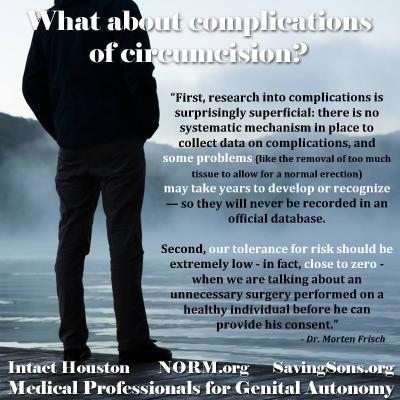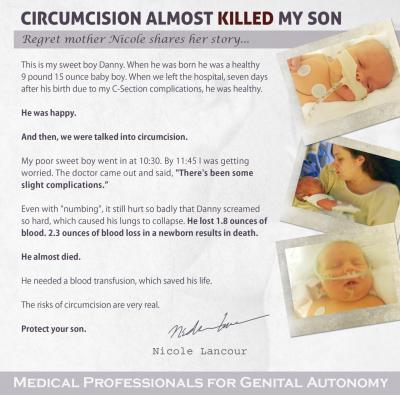The "Official" List
The known possible complications of circumcision are well documented, and should be widely known in the medical community. However, most doctors won't admit the full list of complications or their rate of occurrence, and therefore most parents are not aware. When handing their child over to be circumcised, they are essentially giving an UNinformed consent to the procedure.
- Bleeding - This is the most common complication. Usually the foreskin is completely crushed where the cut will be made, and this limits the amount of bleeding that occurs. However, accidents do happen, and bleeding is the most common complication. Occasionally the crush is incomplete, the scalpel didn't exactly follow the crush line, or there is a genetic bleeding disorder. Uncontrolled bleeding may necessitate blood transfusions; in severe cases it can and has led to death.
- Infection - A possibility any time skin is cut, anywhere on the body. With circumcision it is from the conditions not being sterile during the procedure or later (particularly for infants) when the open wound is exposed to feces in the diaper, and/or other germs during diaper/ bandage changes.
- Excessive Foreskin Removed - Depending on the procedure being used and the aggressiveness of the doctor, it is really easy for too much skin to be removed. This can be immediately obvious such as in the case of a completely de-gloved penis, or not show up later when erections are painfully tight.
- Insufficient Foreskin Removed - This is usually a cosmetic issue, where the parents are not "satisfied" with the final appearance (what about the child himself?!) because it might appear like he wasn't circumcised, and they may schedule a second circumcision. In some cases though, the remaining foreskin can touch the glans and form adhesions (see below) or push forward beyond the glans and become narrow as it heals and scars, causing phimosis (see below).
- Adhesions - At birth, the foreskin is naturally fused to the glans (and would remain that way for several years), so the first step of circumcision is to break that adhesion. Post-circumcision adhesions are areas of the foreskin that were not separated at all, or where the insufficiently separated membrane was able to reattach.
- Skin Bridges - When the raw open wound of the foreskin edge touches a raw open wound on the edge of the glans and the two begin to heal together. This creates a permanent bond between them, with a void underneath - hence the term bridge. They can be as narrow as a thread, or as wide as the entire circumference of the penis. Debris can collect underneath the bridge and may create a hygiene problem. The bridge may also create uncomfortable skin tension, sometimes the restriction is so severe its tension causes a curve in the penis. Cutting the bridge may be necessary. The true incidence of skin bridge complications is unknown, but from relatively recent self-reporting surveys they may be much more common than previously thought.
- Inclusion Cysts - Usually occurring along the cut edge, these are thought to be the result of either smegma accumulating in the incision or from the epidermis rolling in at the time of the procedure. They may cause no issues or they may need to be excised.
- Abnormal Healing - Granulomas along the cut edge and kleiod formation have occurred in some cases.
- Meatitis - an infammation of the urethral opening, often appearing abnormally red. Occurs mildly after most circumcisions but usually not long-lasting as the glans surface thickens. When this is a chronic condition, it can lead to meatal stenosis (see below).
- Meatal Stenosis - A narrowing of the urethral opening resulting from either chronic meatitis / irritation of the glans forming scar tissue there, or from mild loss of bloodflow during the circumcision procedure. This narrowing can cause deflection of the urine stream, dribbling of urine, or in severe cases, painful urination. May require meatomy - a medical procedure to widen the opening.
- Urinary Retention - A circular bandage/ tape applied too tightly can create an obstruction to urine flow, causing retention of urine.
- Phimosis - The inability to retract the foreskin. In intact newborns, the foreskin is fused to the glans, so it is normal for it to not retract, perhaps even until puberty. In intact toddlers and children, phimosis is usually caused by premature forced retraction rather than a problem with the foreskin itself. For circumcised boys, however, the cut edge of the foreskin can pull together as it heals and "trap" the penis under the circumcision site. Phimosis can sometimes be treated with stretching exercises and seroid creme applications, but other times a surgical correction may be necessary.
- Chordee - a ventral curvature of the penis. Can be congenital (present at birth) because of abnormally formed corporal bodies inside the penis, in which case it is a contraindication to circumcision. When it develops after the circumcision, it is thought to be due to uneven amount of foreskin being removed, and the asymmetric tension causes the glans to deviate from being straight.
- Hypospadias - Urethral opening present on the underside of the glans rather than at the tip. Can be congenital (present at birth) from a malformed urethra, in which case it is a contraindication to circumcision. When it develops after the circumcision it is thought to be due to improper placement of the circumcision clamp causing an injury to the glans. This condition may not cause problems, or surgical correction may be necessary.
- Epispadias - Urethral opening present on the top side of the glans rather than at the tip. Can be congenital (present at birth) but that is rare. When it develops after the circumcision, it is thought to be due to the device used for the dorsal slit being inserted into the urethra inadvertently. Surgical correction may be necessary.
- Urethrocutaneous Fistula - Creation of a passageway between the urethra and the outer skin of the penis. A rare complication, but still occasionally happens, usually as a result of damage to the urethra from aggressive clamping or suturing on the ventral surface of the penis. Surgical correction is necessary.
- Necrosis of the Penis - When part of the penile tissue starts to die. Rare, but has been reported, usually due to a serious infection setting in or accident during the use of an electrocautery device to control bleeding.
- Amputation of the Glans - This devastating complication is rare, but still occurs several times per year. Usually because of inappropriate placement of the circumcision clamp. More common with the Mogen clamp than the others. If recognized and treated immediately, reattachment may be possible.
- Death - Another rare complication, but it still happens an estimated 100+ times per year. Usually related to blood loss or an infection that turns septic (throughout the whole body). Actual statistics on this are hard to determine because the cause of death is often listed as the directly observable problem (such as uncontrolled bleeding or infection) even though that condition was actually initiated by the circumcision.
* The list above was adapted from the Stanford School of Medicine (accessed Apr. 2017).
What Does "Rare" Mean?
Many of the complications listed above are said to be rare. But it doesn't matter how low the percentage of occurrence is when it happens to you or your son - it is just as devastating as the most common of complications.
And to claim that something is rare, you first need to know its true rate of occurrence. Statistics on these problems are extremely difficult to obtain, for a multitude of reasons. Many of the problems don't present themselves until the person reaches puberty. By that point, the doctor who actually performed the circumcision (and therefore would be the most responsible to report the complications) is not likely still involved in that person's health care. If the problem finally comes to light during puberty or after, the self-conscious boy or man is not likely to report the issue to his parents or doctor. Also, having lived with these issues his whole childhood, the he may not even realize something is wrong and assume that is the way it is supposed to be. When the boy or man finally recognizes the problem, there isn't any way to directly attribute and report the issue as having been a complication of his circumcision years or decades before. And more to the point, there isn't any official medical agency to which these reports would be submitted. Thus the statistics that try to pinpoint the actual rate of circumcision complications will always be under-reported and inaccurate.
Global Survey of Circumcision Harm
"...It still hurt. So badly, in fact, that my poor 10 day old baby screamed SO HARD that his lung collapsed. He also lost 1.8oz of blood. 2.3 ounces of blood loss causes death for a newborn. This is not as rare as they'd like you to believe..."
-Nicole's experience with her boy, Danny, posted on Saving our Sons.
In an effort to gather personal testimony and compile data on the full scope of the harm of circumcision, Tim Hammond founded the first known Global Survey of Circumcision Harm. He uncovered many, many more problems that are occurring as a result of circumcision. The original results were published in BJU International in 1993. The survey was re-launched in its current online version in 2011. (It is now closed to responses, but the data is available.) Watch and listen to his presentation (YouTube) of the updated findings at the Genital Autonomy Conference, Frankfurt, May 2015. The results were also recently published within the article "Long-term adverse outcomes from neonatal circumcision reported in a survey of 1,008 men: an overview of health and human rights implications" (2017), in the International Journal of Human Rights.
Tim's findings include:
- Physical issues such as an extremely pronounced circumcision scar, drastic skin tone differences on either side of the scar, an uneven cut, a non-congenital twist or bend in the penis when erect, pubic hair extending high on the shaft of the penis, and several others.
- Sexual problems such as a painful or numb circumcision scar, painfully tight erections, erectile dysfunction, an insensitive glans, need for excessive lubrication and/or stimulation to achieve orgasm, and others.
- Emotional tolls such as dissatisfaction or frustration with having been circumcised, the feeling of having been raped and/or mutilated, the feeling of having been betrayed by those who were supposed to protect us (parents, clergy, doctors, etc), shame, suicidal thoughts, addictions, self-destructive behaviors and so on.
- Difficulties in social relationships with other people, as well as difficulties in intimate relationships (even non-sexual) with partners and spouses.
These long-term consequences of circumcision cannot be discounted or ignored.
Additional Links and Information




